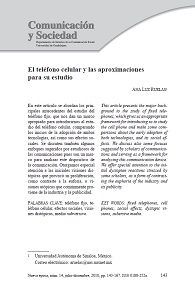El teléfono celular y las aproximaciones para su estudio
DOI:
https://doi.org/10.32870/cys.v0i14.1284Palabras clave:
teléfono fijo, teléfono celular, efectos sociales, visiones distópicas, medio subversivoResumen
En este artículo se abordan los principales antecedentes del estudio del teléfono fijo, que nos dan un marco apropiado para introducirnos al estudio del teléfono celular, comparando los inicios de la adopción de ambas tecnologías, así como sus efectos sociales. Se discuten también algunos enfoques sugeridos por estudiosos de las comunicaciones pues son un marco para analizar este dispositivo de la comunicación. Otorgamos especial atención a las iniciales visiones distópicas que provocó su proliferación, como contraste a la euforia, o visiones utópicas que comúnmente proviene de la industria y la publicidad.Descargas
Citas
Brown, B. (2002). Studying the use of mobile technology. En B. Brown, N. Green & R. Harper (Eds.), Wireless world. Social and interactional aspects of the mobile age (pp. 3–15). Londres: Springer–Verlag.
Cabrera, D. H. (2006). Movimiento y conexión. Política y Sociedad, 2, (46), 91–105.
Cooper, G. (2002). The mutable mobile: social theory in the wireless world. En B. Brown, N. Green & R. Harper (Eds.), Wireless world. Social and interactional aspects of the mobile age (pp. 19–31). Londres: Springer–Verlag.
Cutting the cord. (1999, 9 de octubre). The Economist, pp. 6–12.
De Sola Pool, I. (Ed.). (1977). The social impact of the telephone. Cambridge: MIT Press.
Dimmick, J. W., Skiand, J. & Patterson, S. J. (1994, octubre). The gratifications of the household telephone. Sociability, instrumentality, and reassurance. Communication Research, 21 (5), 643–663.
Dunbar, R. (2002). Grooming, Gossip, and the Evolution of Language. Cambridge, MA.: Harvard University Press.
Fischer, C. (1991). America calling: a social history of the telephone to 1940. Berkeley: University of California Press.
Fortunati, L. (2003). The mobile phone and democracy: an ambivalent relationship. En K. Nyíri, Mobile democracy . Essays on society, self and politics.(pp. 239–258) Viena: Passagen Verlag.
García, L. (2008). Las ciencias de la comunicación a la luz de las nuevas tecnologías: retos para una disciplina en la incertidumbre. Global Media Journal—Edición Iberoamericana, (5)10. Recuperado el 31 de enero de 2010 de http://gmje.mty.itesm.mx/lascienciasdelacomunicacion.pdf
Geser, H. (2005). Is the cell phone undermining the social order? Understanding mobile technology from a sociological perspective. En P. Glotz, S. Bertschi & C. Locke (Eds.), Thumb culture. The meaning of mobile phones for society (pp. 23–35). Bielefeld: Verlag.
Goldberger, P. (2003). Disconnected urbanism. The cell phone has changed our sense o f place more than faxes, computers, and e–mail. Metropolis. Recuperado el 29 de octubre de 2008 dehttp//:www.metropolismag.com/story/20070222/disconnected–urbanism
Hoflich, J. R. (2005). The mobile phone and the dynamic between private and public communication: Results of an international exploratory study. En P. Glotz, S. Bertschi & C. Locke (Eds.), Thumb culture. The meaning of mobile phones for society (pp. 123–135). Bielefeld: Verlag.
Ibarra López, A. M. (1995). Apuntes para una historia de la telecomunicación en México. Revista Comunicación y Sociedad, 22–23, septiembre 1994–abril 1995, 103–146.
Kasesniemi, E. & Rautianen, P. (2002). Mobile culture of children and teenagers in Finland. En J. E. Katz & Aakhus, M. (Eds.), Perpetual contact. Mobile communication, private talk, public performance (pp. 170–192). Cambridge: Cambridge University Press.
Katz, J. E. (1999). Connections. Social and cultural studies of the telephone in American Life. New Brunswick, NJ.: Transaction Publishers.
Katz, J. E. (2005). Mobile communication and the transformation of daily life: The next phase of research on mobiles. En P. Glotz, S. Bertschi & C. Locke (Eds.), Thumb culture. The meaning of mobile phones for society(pp. 171–182). Bielefeld: Verlag.
Katz, J. E., Aarhus, M., Kim, H. D. & Turner, M. (2003). Cross–cultural comparisons of ICTs. En L. Fortunati, J. E. Katz & R. Riccini, (Eds.), Mediating the human body. Technology, communication, and fashion (pp. 75–86). Nueva Jersey; Londres: Lawrence Erlbaum Associates.
Kopomma, T. (2000). The city in your pocket. Birth of the mobile information society. Helsinki: Gaudeamus.
Lasen, A. (2005). History repeating? A comparison of the launch and uses of fixed and mobile phones. En L. Hamill & A. Lasen (Eds.), Mobile world. Past, present and future, (pp. 929–960). Netherlands: Springer.
Ling, R. & Yttri, B. (2002). Hyper–coordination via mobile phones in Norway. En J.E. Katz & M. Aakhus (Eds.),Perpetual contact. Mobile communication, private talk, public performance (pp. 139–169). Cambridge: Cambridge University Press.
Ling, R. (2003). Fashion and vulgarity in the adoption of the mobile telephe among teens in norway. En L. Fortunati, J. E. Katz & R. Riccini (Eds.), Mediating the human body. Technology, communication, and fashion (pp. 93–102). Nueva Jersey; Londres: Lawrence Erlbaum Associates.
Ling, R. (2004). The mobile conection. The cell phone's impact on society. Amsterdan: Morgan Kaufmann.
Marvin, C. (1988). When old technology were new. Thinking about electric communication in late nineteenth century. Nueva York: Oxford University Press.
May, H. & Hearn, G. (2005). The mobile phone as media. International Journal of Cultural Studies, 8, (195),195–211.
Miyaki, Y. (2005). Keitai use among Japanese elementary and junior high school students. En M. Ito, D. Okabe & M. Matsuda (Eds.), Personal, portable, pedestrian. Mobile phones in Japanese life (pp. 277–299). Cambridge; Londres: The MIT Press.
Nyiri, K. (Ed.). (2003). Mobile democracy. Viena: Passengen Verlag.
Nyiri, K. (2005, 28–30 de abril). The mobile phone in 2005: where are we now? Conferencia presentada en el congreso internacional Communications in the 21st century. The mobile information society "Seeing, understanding, learning in the mobile age". Budapest: Hungarian Academy of Sciences/T–Mobile.
Palau, M. (2008). La transdisciplinariedad en los estudios de medios de comunicación en Mexico. Global Media Journal —Edicion Iberoamericana, 5 (10). Recuperado el 30 de enero de 2010 dehttp://gmje.mty.itesm.mx/latransdisciplinariedad.pdf
Poster, M. (2004). Consumption and digital commodities in the everyday. Cultural Studies, 18 (2–3), 409–423.
Rakow, L. F. & Navarro, V. (1993). Remote mothering and the parallel shift: women meet the cellular telephone.Critical Studies in Mass Communication, 10, 144–157.
Reid, D. J. & Reid, F. J.M. (2005). Textmates and text circles: insights into the social ecology of SMS text messaging. En L. Hamill & A. Lasen (Eds.), Mobile world. Past, present and future (pp. 105–118). Netherlands: Springer.
Reinghold, H. (2002). Smart Mobs. The next social revolution. Cambridge, MA.: Perseus Publishing.
Reardon, K. & Rogers, E. M. (1988). Interpersonal versus mass media communication. A false dichotomy.Human communication research, 5 (2), Invierno. 284–303.
Rogers, E. (1986). Communication technology: the new media in society. Nueva York: Free Press.
Ruelas, A. L. & Ramírez, A. E. (2008, septiembre). Internet y cibercafés en Culiacán. Enfoques y realidades.Revista Razón y Palabra, 64. Recuperado el 30 de enero de 2010 dehttp://www.razonypalabra.org.mx/N/n64/varia/ruelas_ramirez.html
Ruelas, A. L. (2010). El teléfono celular y los jóvenes sinaloenses. Adopción, usos y adaptaciones. Borrador para publicación.
Sarch, A. (1993). Making the connection: single women's use of the telephone in dating relationships with men.Journal of Communication, 43 (2), 28–144.
Sawney, H. (2005). Wi–f networks and the reorganization of wireline–wireless relationship. En R. Ling & P. E. Pedersen (Eds.), Mobile communications. Renegotiation of the social sphere (pp. 45–61). Londres: Springer.
Serrano Santoyo, A. & Martínez Martínez, E. (2003). La brecha digital. Mitos y realidades. México: UABC.
Williams, F., & Rice, R. E. (1993). Communication research and the new media technologies. En R. N. Bostron, y B. H. Westley (Eds.), Communication Yearbook, 7, 200–224. Beverly Hills: Sage.

Descargas
Publicado
Cómo citar
Número
Sección
Licencia
Los autores/as que publiquen en esta revista aceptan las siguientes condiciones:
De acuerdo con la legislación de derechos de autor, los autores conservan los derechos de autoría y otorgan a Comunicación y Sociedad el derecho de primera comunicación pública de la obra. Comunicación y Sociedad no realiza cargos a los autores por enviar y procesar artículos para su publicación.
Los autores/as pueden realizar otros acuerdos contractuales independientes y adicionales para la distribución no exclusiva de la versión del artículo publicado en Comunicación y Sociedad (por ejemplo incluirlo en un repositorio institucional o publicarlo en un libro) siempre que indiquen claramente que el trabajo se publicó por primera vez en Comunicación y Sociedad.










